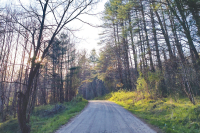Balancing Act: The Greater Waynesville Wine Race
 Running downhill with a tray of wine glasses, Janelle Trevino had a simple objective: she didn’t want to drop any.
Running downhill with a tray of wine glasses, Janelle Trevino had a simple objective: she didn’t want to drop any.
“It was intense,” Trevino said. “It’s a lot harder than it looks. I was pretty nervous.”
A server at Tipping Point Brewing in Waynesville, Trevino and her three teammates participated in The Greater Waynesville Wine Race on April 26. Taking place on Miller Street in downtown Waynesville, the spectacle, put on by the Relay for Life of West Haywood, brought together a handful of local restaurants to raise awareness of cancer through a fun and unique occasion.
Get out: Waynesville and Jackson county look to the mountains for parks programming
 Mountains and rivers shape the landscape of Western North Carolina, but when it comes to recreation programming, counties and municipalities tend to focus on facilities and league sports. Both the town of Waynesville and Jackson County, however, are working to look beyond the status quo to point people toward the beauty in their own backyards.
Mountains and rivers shape the landscape of Western North Carolina, but when it comes to recreation programming, counties and municipalities tend to focus on facilities and league sports. Both the town of Waynesville and Jackson County, however, are working to look beyond the status quo to point people toward the beauty in their own backyards.
Vision quest: Waynesville officials attempt glimpse into future
 After a full day of brainstorming, the Waynesville Board of Aldermen had thrown a lot of meat onto the table. Ideas, concerns and potential opportunities were written down on giant pieces of paper and tacked up on the walls, canvassing a good portion of the meeting room overlooking Lake Junaluska.
After a full day of brainstorming, the Waynesville Board of Aldermen had thrown a lot of meat onto the table. Ideas, concerns and potential opportunities were written down on giant pieces of paper and tacked up on the walls, canvassing a good portion of the meeting room overlooking Lake Junaluska.
Trick bikes fall from grace at Waynesville’s skate park
 The Waynesville skate park became an instant rock star after its debut last fall, gaining repute as a wildly popular concrete playground for all things on wheels gliding, sliding and flying over the ramps and rails all hours of the day.
The Waynesville skate park became an instant rock star after its debut last fall, gaining repute as a wildly popular concrete playground for all things on wheels gliding, sliding and flying over the ramps and rails all hours of the day.
Gambling halls raided
 Two video gambling halls were raided in Haywood County last week following an undercover investigation by law enforcement agencies.
Two video gambling halls were raided in Haywood County last week following an undercover investigation by law enforcement agencies.
On with the show
 Though the process has been long, Steven Lloyd is beginning to see the fruits of his labor.
Though the process has been long, Steven Lloyd is beginning to see the fruits of his labor.
“I sometimes feel like I’ve pushed a big boulder up a hill and it’ll fall backwards,” he said. “But, the momentum is still going. We’re a proven, successful theatre, and this is going to happen.”
Sewing traditions together: Weaver attracted by all facets of ancient art
 Sitting at her loom, weaver Amy Tromiczak feels right at home.
Sitting at her loom, weaver Amy Tromiczak feels right at home.
“It’s an amazing thing. You’re making cloth, and I love it,” the 25-year-old said. “It’s all about the whole process of choosing your fibers, deciding what kind of cloth to make, seeing it laid out on the loom.”
Car charging stations to be installed in Waynesville
Electric car owners will soon have the option of charging their vehicles in downtown Waynesville.
Mixed feelings among residents on new plans for old prison
 By Jake Flannick • SMN Correspondent
By Jake Flannick • SMN Correspondent
Haywood County leaders have all but signed off on plans by a pair of faith-based groups running social service ministries in the county to convert a defunct state prison into a homeless shelter and halfway house.
Forest fixer-upper: Logging clears the way for a more ecologically robust watershed
 The silence seeped from the mountain ridges and hung heavily over the forest, silence like a deep well, so deep that a pebble tossed in just might go on forever, swallowed up for what seems like an eternity until at last, a dim, muffled plunk echoes up from in the darkness far below.
The silence seeped from the mountain ridges and hung heavily over the forest, silence like a deep well, so deep that a pebble tossed in just might go on forever, swallowed up for what seems like an eternity until at last, a dim, muffled plunk echoes up from in the darkness far below.
It was the kind of quiet so steadfast, so impenetrable, little stood a chance against it.













